Early inhabitants of Middletown Point relied upon local merchants to manufacture and sell stoneware and earthenware crocks and jugs for food and drink storage. Various historians and pottery collectors over the years have studied and chronicled the development of this industry, which is set forth, below.
The earliest example of local pottery appears to be a crock in the Newark Museum marked “IVS/My 27 1805” attributed to Josiah Van Schoick, Middletown Point, according to James S. Brown in an article for the Asbury Park Press on July 13, 1975. Brown cautioned that the provenance of this cannot be verified, although he found a listing in the New Jersey Archives for an individual by that name in Monmouth County in 1813. This may be the father of Matawan’s Josiah Van Schoick (1822-1898), who will be fully described below.
Matawan is a logical place for potteries to thrive, due to the clay deposits at the Cheesequake Creek area. Brown noted that this locale supplied potters in the area with clay in the 18th and 19th century, as well as shipments being sent to potteries up the Hudson River and to New England.
A 1765 advertisement in the New York Mercury offered “plain tyles” made by Daniel Hendrickson at Middletown Point. 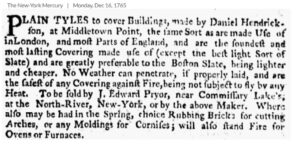 This Daniel appears to be mentioned in the tract Rethinking the Mengkom-Mixing Bowl: Salvage Archaeology at the Johannes Luyster House, A Dutch-American Farm by Richard F. Veit, 2001. The article noted “It is worth noting that the Luyster’s need not have relied so heavily on imported ceramics. Their neighbor and close family friend, Daniel Hendrickson, scion of another Dutch emigre family, was a redware potter during the late 18th century. He produced a variety of vessels including porringers, jugs, platters, mugs, basins, bowls, and cups. Moreover, in nearby Cheesequake, the Morgans, Van Wickles, and other local families were actively producing a variety of stoneware products.” This individual may or may not be the Hendrickson noted in the Mercury article, but it seems to fit.
This Daniel appears to be mentioned in the tract Rethinking the Mengkom-Mixing Bowl: Salvage Archaeology at the Johannes Luyster House, A Dutch-American Farm by Richard F. Veit, 2001. The article noted “It is worth noting that the Luyster’s need not have relied so heavily on imported ceramics. Their neighbor and close family friend, Daniel Hendrickson, scion of another Dutch emigre family, was a redware potter during the late 18th century. He produced a variety of vessels including porringers, jugs, platters, mugs, basins, bowls, and cups. Moreover, in nearby Cheesequake, the Morgans, Van Wickles, and other local families were actively producing a variety of stoneware products.” This individual may or may not be the Hendrickson noted in the Mercury article, but it seems to fit.
Brown cited an advertisement in the Freehold Monmouth Inquirer dated July 29, 1830 offering earthenware, furnaces and tile by G. and W. Hickman’s “Earthenware Manufactory of Middletown Point.” This edition is not digitalized in a collection I have access to. I did, however, locate an advertisement for Richard Low’s “Earthenware Factory” in Middletown Point in the Monmouth Democrat’s June 7, 1838 edition. 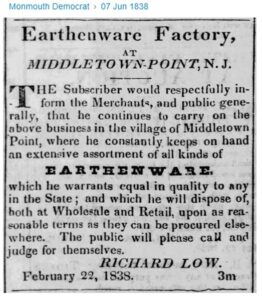 This supposedly operated in the rear of William Little’s store in town and was in business until 1850, according to The History of Monmouth County by Franklin Ellis.
This supposedly operated in the rear of William Little’s store in town and was in business until 1850, according to The History of Monmouth County by Franklin Ellis.
Additionally, Brown informed that another edition of the Inquirer that year indicated one John A. Campbell was taking over the Union Hotel in Middletown Point and would operate an earthenware manufacturing occupation at the establishment.
A 1956 catalog of a New Jersey pottery exhibit at the State Museum noted a straight-sided pot marked “A. Price/Middletown Point” that was displayed. The publication indicated that Price had a business relationship with well-known Matawan resident Simon Arrowsmith in this regard. Further research identified this individual as Abiel Price, who died in Middletown Point on February 9, 1852. His occupation was listed as “potter” on the Middletown Point 1850 census. Decorated Stoneware Pottery of North America by D.B. Webster (1971) lists him as a potter in Middletown Point from 1847 to 1852.
On November 6, 1845, Price placed an ad in the Monmouth Democrat offering “Stone, Earthen and Crockery Ware” at Middletown Point, noting that he had 5000 drainpipe tiles of the best quality on hand. He also offered “one dozen Stone Pans and one Churn to any Farmer that will give me the excess Butter that will arise on the above Pans over Tin and Earthen ware pans in one season, who will try the experiment. The Pans and Churn will be ready the 1st of April 1845.”
Pottery produced by him was generically termed “Price Pottery,” a name that was associated with locally produced earthenware years after his death.
In the mid-1800s, the construction of pottery and tile took off in town, with the partnership of Josiah Van Schoick (1822-1898) and Ezra Dunn (1821-1898). Established in 1853, this firm, although with various name changes throughout its existence, is still operating 170 years later – the longest continually operated business in Matawan.
Van Schoick & Dunn (1853-1873)
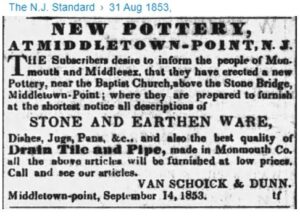 The company started operation at the corner of Washington and Jackson Streets, above the “Gully Bridge” and was known familiarly as “The Matawan Pottery.” Clay deposits were exploited along Aberdeen Creek and what is now Terhune Park across Main Street, which caused the depression and hill now used for sledding by Matawan youth in the winter.
The company started operation at the corner of Washington and Jackson Streets, above the “Gully Bridge” and was known familiarly as “The Matawan Pottery.” Clay deposits were exploited along Aberdeen Creek and what is now Terhune Park across Main Street, which caused the depression and hill now used for sledding by Matawan youth in the winter. 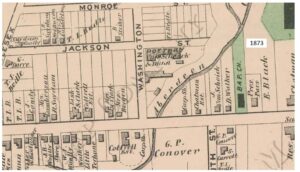
Besides stone and earthenware, drain tiles were manufactured. The factory supplied a large portion of Monmouth as well as northern Ocean County, loading their product in large wagons which made two-day trips marketing the goods.
Starting with two kilns, they expanded and needed a better system to power their factory than traditional horse-powered “engines” to supply turning motion to their various wheels used in turning pots and vessels. In 1870, they introduced a steam engine, which may have been the earliest of its type in Matawan. In May of the following year, a young potter named “Cady” was caught in the machinery and was “carried several times around the shaft” with his arm severely broken and his hand mutilated. He most likely bears the unfortunate distinction of the first person in Matawan to be injured by “modern” equipment on-the-job.
Van Schoick & Dunn stoneware is very collectible – the MHS has signed examples displayed in the Burrowes Mansion Museum. 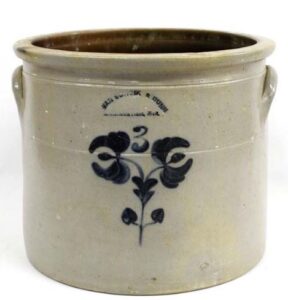
Dunn, Dunlop & Co. (1873-1899)
On October 25, 1873, the Van Schoick and Dunn partnership was dissolved and Ezra Dunn’s brother-in-law, William Allen Dunlop (1833-1910) bought out Van Schoick. They appear to subsequently specialize in “horseshoe” drainage tile and clay piping and had numerous contracts with governmental bodies to provide the product for bridges and roads.  There is a strong probability that existing clay sewer pipes in homes in Matawan built in the late 19th century were made at their factory.
There is a strong probability that existing clay sewer pipes in homes in Matawan built in the late 19th century were made at their factory.
Josiah Van Schoick died in July of 1898 and Ezra Dunn the following November, at which time Edward Lewis Lisk (1873-1940) and Dunlop reorganized the company. Dunlop retired in 1907, selling his interest to Wesley Shafto (1880-1947). The firm was renamed “Dunlop & Lisk Pottery Company”, but William Dunlop had no further financial interest in the business. Both new partners were young in 1907 – Lisk, 34 and Shafto, 30. Dunlop died three years later, at which time Shafto sold his interest to Lisk who operated it by himself until 1923, when his half-brother, Emerson Jackson Lisk (1883-1959), a local contractor, bought in.
The company appeared to expand its product line to sand, gravel, cement blocks and cut stone (I purchased stone from them for my new porch steps recently.)
After Edward Lisk died in 1940, his brother Emerson sold his interest to realtor Ross W. Maghan of Matawan and Garrett Post of Keyport. They continued small time operations at the plant until the end of WWII, then resumed manufacturing clay products.
In January of 1952, a fire devastated the company, destroying 80% of the plant and causing $20,000 worth of damage. The structure destroyed was the main building, 150’ by 80’, and consisted of a good portion of the 100-year-old original factory. Garret Post was the firm’s treasurer at the time, with its president listed as Charles Fish Perrine (1903-1997) and vice president Raymond McIlvaine of Holmdel. (Perrine was related to the Rue Pottery Company’s founder and until 1993 lived on Schenck Avenue in Matawan.)
The company considered rebuilding on its old site but decided to relocate to Freneau on Route 79 where it operates from today. Feld Refractories attempted to build a chinaware factory on the old site, but residents fought the proposal and the Borough Council rejected its application in September of 1952. A residence, 17 Washington Street, now stands on the former pottery site.
The families of Van Schoick, Dunn, Dunlop and Lisk will be listed in the Matawan Surname Section of this site.
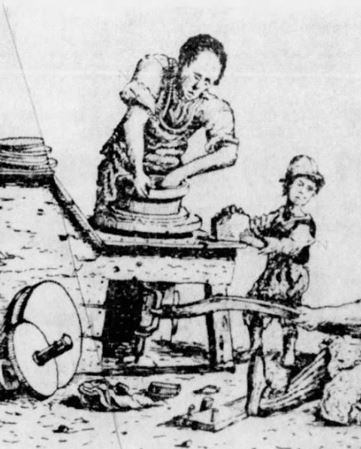
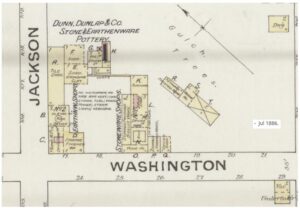
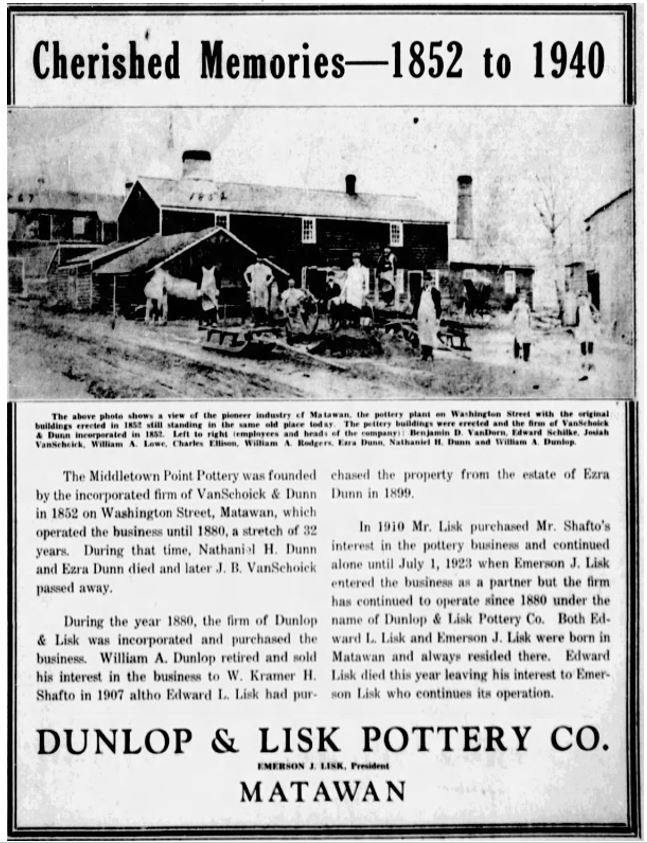
Pingback:Van Schoick, Josiah (1822-1898) - Matawan Historical Society